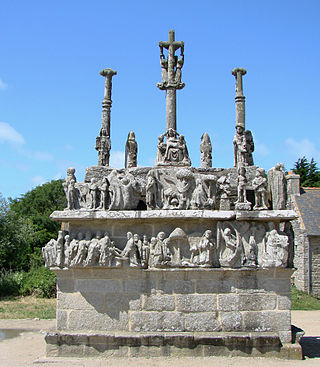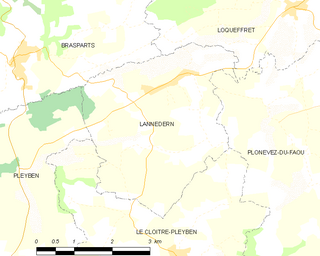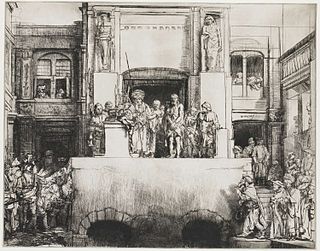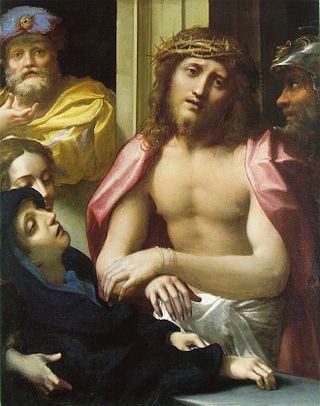
The Calvary at Pleyben, dating from 1555, is located in the village of Pleyben in Brittany, northwestern France.

The Calvary at Pleyben, dating from 1555, is located in the village of Pleyben in Brittany, northwestern France.
The Calvary dates to 1555 and most of the sculpture involved was executed by the workshop of Henry and Bastien Prigent who also worked on the Plougonven and Lopérec calvaries. Originally a statue of St Germain had been part of the calvary but this was moved to the church porch. This statue is inscribed "EN L´HONNEUR DE DIEV ET (NOTRE) DA (M) E ET MONSIEUR S GERMAIN CESTE CROIX FVST COME (N) CE 1555" and this has been used to fix the calvary's date. In 1650, it was enriched by the addition of several new sculptures including the Entry into Jerusalem, the Last Supper and the scene where Jesus is washing Peter's feet. These were the work of the Yves Ozanne studio/workshop in Brest. Originally it was placed near the church porch but between 1738 and 1742, it was moved to improve access to the church. This work was carried out by the Pleyben entrepreneurs, Guillaume Le Goff, Yves Quiniou and François Motreff, and it is thought that at this time the structure could well have been modified and enlarged. The calvary has been restored on several occasions notably in 1953 and more recently in the years 1980 to 1990. [1] The granite used came from a quarry near Gulvain.
It has two distinct levels. The lower level comprises a corniche running around the entire structure and the upper level or platform. Four buttresses strengthen the calvary and an arcaded passage runs through the centre producing an Arc de Triomphe like effect. The statuary decorating the calvary, placed either on the platform or on the corniche, is carved from kersanton stone or in some cases from grey arkos, a stone less resilient to erosion. The calvary should be read anti-clockwise starting with the Annunciation on the corniche of the southwest buttress and ending with the Crown of thorns episode, whereas on the platform, one's reading should start with the "Ecce Homo" scene and finish with the "Descent into Hell". The "Mise au tombeau" is placed in the centre. The sculptures on the lower level (the corniche) are smaller than those on the platform. [1] [2] [3]
On the south facing corniche, the statuary covers the Annunciation, the Visitation (Christianity), the Nativity of Jesus, the Adoration of the Magi and the Flight into Egypt with a scene showing Jesus meeting the lawyers placed in the southeast corner. On the east facing corniche, the statuary covers the Entry into Jerusalem, the Last Supper and the Foot washing. On the north face corniche, the statuary covers Jesus in Gethsemane, scenes around Jesus' arrest, and his appearance before Pontius Pilate. On the northwest corner corniche is a Pietà and then on the east face corniche is a depiction of Jesus being mocked ("Christ aux outrages") followed by Peter's denial, Jesus' flagellation and the scene where a crown of thorns is pressed on Jesus' head. On the calvary's upper surface (the platform) southeast corner is the scene depicting the "Ecce Homo" with Pontius Pilate wearing a Phylactery inscribed "ECCE HOMO" and pointing to Jesus and one of Jesus' accusers whose Phylactery reads "TOLLE TOLLE CRVCIFIGE EVM". He asks that Jesus be crucified. On the northeast corner of the platform, Pontius Pilate is depicted washing his hands. On the north face part of the platform is the scene showing Christ carrying the cross. [1]

From the centre of the platform, three crosses reach up to the sky and on the central cross, Jesus is surrounded by five angels, four of whom collect the blood from his wounds whilst the fifth is ready to carry off his soul. On the reverse side is a depiction of "Christ triumphant" who holds up his right hand whilst his left hand draws attention to the wound in his side. On the two smaller crosses are the two robbers whose legs have been broken to hasten their death, inscriptions identify the Penitent thief as "Dismas" and the Impenitent thief as "Gismas." An angel is ready to take the good robber's soul to heaven whilst a grimacing demon is ready to take the soul of the bad robber. There are statues of the Virgin Mary and John the Evangelist at the base of the cross. Mary's face is bathed in tears whilst John looks up towards Jesus, his left hand raised. [1]

There are statues of seven cavaliers/soldiers spread about the calvary's platform including Saint Longinus who carries a lance. The main depiction on the west face covers the Resurrection of Jesus with Jesus emerging from the tomb. Around him two soldiers are seen to be sleeping whilst a third, blinded by the scene unfolding before him, shields his eyes as he falls to the ground. On the corniche below and on the side of the buttress is a pietà which, according to the inscription, was added in 1738. Then we see the scene where Jesus is mocked by two soldiers and a blindfold is about to be put over his eyes ("Christ aux outrages"). This is followed by a depiction showing the Denial of Peter. Peter kneels in prayer before a rock on which two birds are perched. Old postcard photographs show that the image of a rooster once topped the rock but this has disappeared. Of Breton's great calvaries only that at Pleyben deals with Peter's denial of Christ. Then we see Jesus being flogged by three soldiers, this scene followed by his being crowned with a crown of thorns. [1]

Along the corniche on this face of Pleyben's calvary, we commence on the left side with a scene showing Jesus at prayer in the garden of Gethsemane. John the Evangelist and St Peter are with him but both are asleep. The statue of the kneeling Jesus has now lost its head. We then see Peter standing alone, his sword hanging at his side followed by a depiction of Jesus being arrested. Judas has kissed Jesus to identify him to the guards and he stands clutching a purse and in the ensuing melée, the guard Malchus has been knocked to the ground having been hit with his sword by Peter. In the next scene Jesus is being presented to the High Priest Caiaphas who sits on his throne. On the northeast corner of the north face platform we see Jesus being brought before Pontius Pilate. In the Christ carrying the cross scene which follows and dominates the north face, we start on the right hand side with a depiction of Longinus who leads the procession although confusingly he faces the wrong way. He points to his eye with his finger reminding us that Jesus had cured his blindness. Jesus is clearly struggling with the weight of the cross and Simon of Cyrene tries to help keep it off the ground. In front a soldier is putting his fingers in his mouth to whistle, another soldier pulls on a rope whilst a third, walking behind Jesus, lashes him with a whip. All are frowning except for Jesus whose face remains impassive, his head leaning to one side. St John and the Virgin Mary follow Jesus and the soldiers and John is trying to support Mary. Finally, St Veronica holds out her veil which is now impregnated with Jesus' image. On the corniche we have a scene showing Jesus praying in Gethsemane, then St Peter shown with his sword followed by a scene showing Jesus being kissed by Judas who holds his purse and then arrested with Peter attacking Malchus. We next see Jesus presented to the High Priest Caiaphas who sits on his throne and we then return to the Annunciation. [1]


On the platform of the south facing side of the calvary after some soldiers, depicted standing or on horseback we have the scene depicting the descent into Limbo where Hell is a large open mouth from which Jesus has already led out Adam and Eve and still visible in the mouth are further lost souls held in check by a devil wielding a fork. The mouth is toothless but various imps and demons are also revealed. Jesus holds a pilgrim's staff to underline the length of the journey he has made to reach this place. To the right of the entry into Limbo scene we see another horsed soldier and then the solitary figure of a Jew holding a scroll containing the text of the accusation being made against Jesus. Finally on the right-hand side of the platform there is a soldier dressing Jesus in a "regal robe". Beneath the platform and on the south facing corniche we start on the left-hand side with the Annunciation. There is a visitation scene with Elizabeth meeting with the Virgin Mary. They discuss their mutual pregrancies and Elizabeth tenderly lays her hand on Mary's stomach. The next scene is the Nativity with Joseph and Mary kneeling on either side of the baby Jesus. Further spectators look on in the shape of two small angels and the ass and the cow. This leads on to the scene depicting the Adoration of the Magi, followed by a depiction of the Flight into Egypt and finally on the outside of the buttress to the right we have the scene showing Jesus in discussion with two lawyers. The sculpture of Elizabeth meeting with Mary was the work of Henry Prigent as was the nativity scene whilst Bastien Prigent sculpted the scene depicting the visit of the three wise men. In this scene the characters wear the dress worn in the reign of Henry II. All three wear capes except for Melchior who kneels before the baby Jesus, his hands joined together and with a sword at his side. He has lain his crown on the ground. In the Flight into Egypt, Joseph carries a moneybag and a pilgrim's staff to remind us that he is starting out on a long journey. He also wears the round pilgrim's hat that he is wearing in the "Adoration of the Magi" scene. In the scene with the two lawyers the sculptor shows that Jesus is speaking by depicting him with his right index finger placed on the left thumb. Henry Prigent was the sculptor of this scene. He puts Jesus on a pedestal so that he stands above and looking down on the lawyers. [1]

On the platform, after seeing the depiction of Jesus being dressed in his robe, and a Jew holding the text of Jesus' accusation, we have a "Mise au tombeau". Present at this ceremony are Nicodemus and Joseph of Arimathea, the Virgin Mary and St John, Mary Magdalene holding a pot of ointment, Mary Cleophas, Mary Salome and a Jew who is shown to be speaking by placing his index finger on his thumb. Then we have the "Ecce Homo" scene with Pontius Pilate shown washing his hands, with Jesus held by soldiers standing at his side. On the corniche below we have a scene showing Jesus speaking with the lawyers on the left side buttress and then the Entry into Jerusalem with the inscription "Hossana fili David" this followed by a depiction of the Last Supper with Judas Iscariot on the right holding his purse. We then see Jesus washing St Peter's feet, followed on the buttress to the right by a scene depictig the temptation of Christ with the devil bearded with claws and with large ears. [1]



Note 1: Apart from the Prigent brothers and their team of masons, a major contribution was made to the Pleyben calvary by a sculptor who is known as "Le compagnon de Pleyben". [1] This third sculptor worked in grey sandstone rather than kersantite. The contributions were the heads of the soldiers and the Jewish priest in the "Ecce Homo" scene, Jesus and the devil in the scene depicting the devil tempting Jesus, Saint Peter in the scene depicting the agony in the garden of Gethsemane, all the figures in Jesus' arrest other than Jesus himself, the figures apart from Jesus in the scene depicting the appearance before Caiaphas, all the characters in the "Christ aux outrages" except for Jesus himself, the figures in the flagellation scene apart from Jesus and those in the scene depicting the crown of thorns being applied to Jesus' head again other than Jesus himself. [1]

Scenes from the Passion of Christ is an oil painting on a panel of Baltic oak, painted c.1470 by German-born Early Netherlandish painter Hans Memling. The painting shows 23 vignettes of the Life of Christ combined in one narrative composition without a central dominating scene: 19 episodes from the Passion of Christ, the Resurrection, and three later appearances of the risen Christ. The painting was commissioned by Tommaso Portinari, an Italian banker based in Bruges, who is depicted in a donor portrait kneeling and praying in the lower left corner, with his wife, Maria Baroncelli, in a similar attitude in the lower right corner.

The mocking of Jesus occurred several times, after his trial and before his crucifixion according to the canonical gospels of the New Testament. It is considered part of the passion of Jesus.

The Calvary at Kergrist-Moëlou in the Arrondissement of Guingamp in Brittany, France, dates back to 1578. It was the work of the sculptor Guillaume Jézéquel except for the crucifix which was the work of the sculptor Yves Hernot de Lannion and was remounted on the calvary in 1896. Kergrist-Moëlou is located in the Côtes-d'Armor region, the ancient diocese of Cornouaille. Jézéquel had worked alongside his brother on the Kergrist-Moëlou church in 1554. Originally the calvary's sculpture was substantial, with records showing that it was decorated with almost one hundred statues telling the story of the life and death of Jesus Christ, but the calvary was vandalized during the 1793 French Revolution leaving many statues broken and decapitated with others disappearing completely. What is now left of the calvary stands on a large octagonal granite base and fragments of the mutilated figures are placed around the cross itself. This article gives some of the history of the calvary and describes its constituent parts.
The Calvary of Plougastel-Daoulas in the arrondissement of Brest comprises a raised octagonal pedestal made from the yellow granite of Logonna-Dāaoulas, flanked by four thick arched buttresses. All the sculptural work is by the Maître de Plougastel except the horseman on the left of the crucifix which is by Millet. It is a listed historical monument since 1889.

Calvary at Tronoën is a calvary located at Saint-Jean-Trolimon in the Quimper arrondissement. It is located in the "pays bigouden", a particularly wind swept area of Brittany; the nearby chapelle was called the "cathédrale des dunes".
The Calvary at Guimiliau, completed in 1588, is located in Guimiliau, Brittany, in northwestern France. It is part of the Guimiliau "enclos paroissial".

The Calvary at Plougonven is located within Brittany, France.

The Calvary at Lopérec in the Châteaulin arrondissement in Brittany dates to 1552 and apart from some bas-reliefs around the pedestal was the work of the sculptor Fayet.
The Calvary at Saint-Thégonnec is part of the enclosure of the parish church of Notre-Dame in Saint-Thégonnec. Erected in 1610 it is the last of the monumental calvaries of Brittany. See also Saint-Thégonnec Parish close.

The Ploudiry Parish close is an enclos paroissial located at Ploudiry within the arrondissement of Brest, Brittany. It comprises a church, ossuary, and calvary. The Parish close was built between the 1630s and 1650s, with major renovations taking place in the 18th and 19th centuries.
The Pencran Parish close is located at Pencran in the arrondissement of Brest in Brittany in north-western France. The Notre-Dame church, the sacristy, the two calvaries, the ossuary and the surrounding wall are a listed historical monument since 1990. Records show that there has been a religious building in Pencran since the 14th century, and in 1353 there was mention of a chapel dedicated to the Virgin Mary. Until the French Revolution the parish of Ploudiry covered an area from Loc-Eguiner to Pencran, but it was in 1801 that Pencran became an independent parish.

The Lampaul-Guimiliau Parish close is located at Lampaul-Guimiliau in the arrondissement of Morlaix in Brittany in north-western France. It is a monumental churchyard belonging to the Église Notre-Dame in that town. This church was built in the late 16th century to replace an older one. The structures in the parish close date to the 16th and 17th century. It is a listed historical monument since 1910.

The Plourin-lès-Morlaix Parish close is located at Plourin-lès-Morlaix in the arrondissement of Morlaix in Brittany in north-western France. The Enclos paroissial comprises the Notre-Dame church, a cemetery, ossuary and retaining wall. The church is a listed historical monument since 1932.

The Pleyben Parish close is a historical cathedral complex at Pleyben in the Châteaulin arrondissement of Brittany in northwestern France. The enclosed paroissial comprises the parish church dedicated to Saint Germain of Auxerre, a funeral chapel/ossuary, a triumphal arch serving as the enclosed entrance, and the Calvary at Pleyben. The building is dominated by two bell towers. The rightmost, known as the Saint Germain, is in the Renaissance style and is topped by a lanterned dome; whilst the other has a Gothic style spire. Between the towers is a stair turret with pinnacles and an ornate spire. The close is a listed historical monument since 1846.

The Lannédern Parish close is located at Lannédern in the Châteaulin arrondissement within Brittany in north-western France. The parish close comprises the parish church of Saint-Edern dating to the 16th/17th century and the Saint Anne chapel, originally an ossuary. The church's south porch dates to 1662, the pulpit is 17th century as is the altar and altarpiece. The ossuary stands to the west of the church. The church, calvary and ossuary are listed historical monuments since 1915.

Christ Presented to the People, also known as Ostentatio Christi or Ecce Homo, is a drypoint print by Rembrandt van Rijn which exists in eight states, all c.1655. It is one of the two largest prints made by Rembrandt, about 15 by 18 inches, similar to his 1653 engraving of The Three Crosses. It has been described by Christie's as "at the summit of the western printmaking tradition".

Christ Presented to the People is a mid 16th century painting by Giovanni Antonio Bazzi, an Italian artist commonly known as Il Sodoma. Done in oil on canvas, the work depicts the biblical scene in which Jesus Christ is presented to the people by Pontius Pilate with the phrase "Ecce homo". The painting is in the collection of the Metropolitan Museum of Art.

Ecce Homo, also known as Christ Presented to the People, is an oil painting by Antonio da Correggio. It is the last of the surviving pictures of the Passion of Jesus that Correggio executed during the 1520s. The painting is in the National Gallery, London.